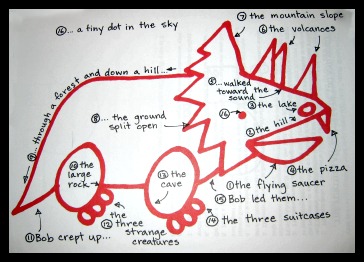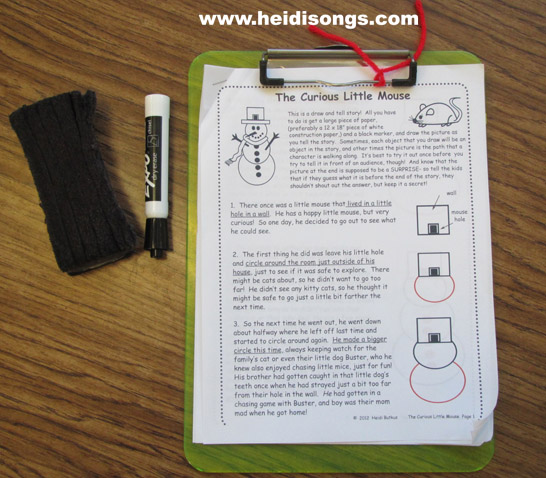Whole Group Games: Entry #3
Have you heard the news? We've Moved to HeidiSongs.tv!
Our new website features an online video streaming service, updated blog posts at Heidisongs.blog, and a wealth of fresh resources designed to make learning even more fun and engaging.
You can also continue shopping for our educational products there and at our Teachers Pay Teachers store!
Head over to HeidiSongs.tv now and explore all the exciting new features.
See you there!
__________________________________________________________________________
Here is entry number three in my whole group games series. This entry contains a lot of story telling techniques that kids seem to love, and that are sure crowd pleasures for me! But first, here is my favorite whole group activity. I’m sure it comes as no surprise to people that are already familiar with my website and my techniques!
What you need:
Music with an academic focus that you can move to, or DVD’s of the same.
Whenever your kids cannot sit any longer, stand them up and keep teaching through music and movement! This will work at the end of the day, right before recess, right before lunch, after opening up Halloween candy, and immediately before dismissing the kids for Christmas vacation! It is my best “trick” and something that I use every day!
Kids LOVE stories that you tell while you draw a simple picture! It’s great to have a few of these up your sleeve. Save a little time to review the story ahead of time and practice drawing it once or twice.
Fold and tell stories, also known as “Storygami,” can be found in books like Fold Along Stories: Quick and Easy Origami Tales For Beginners by Christine Petrell Kallevig. This book is also available at www.storytimeink.com. Watch the author tell some of the tales on youtube.com first to see if this is for you. Just do a search on her name and a video will come up.
This book, called Cut and Tell Scissor Stories for Fall has lots of stories you can tell while cutting little shapes out of a paper plate. The cuts make a picture at the end of the story. Again, you need to figure it out ahead of time! But the children find it enthralling. I find that there is a much better selection of stories for Bible school than there seem to be for regular school; perhaps there are some stories that can be adapted for a public school setting.
This book, Movement Stories For Children Ages 3-6, by Helen Landalf and Pamela Gerke. There are some really fun little stories in here that have the kids moving along with you. You may have to adapt them for your group, though, depending on the size of your class. Some of the motions require too much space or fewer kids. Some of them, though, are absolutely perfect!
For stories like this, google “audience participation stories, and you will find many choices. Or, add the sounds and movements to your own books that you read. Just pause when you come to those words, and wait for the kids to make those sounds or movements. This works well with any story that has repetitive sections.
Example: “Every time I say the word, ‘tiger,’ I want you to ROAR! And every time I say the word, monkey, I want you to say, ‘oo oo oo!'”
Example: “When the little boy runs, I want you to make a running motion like this. And when he walks, I want you to make a walking motion, like this.”
Music and Movement to Review Academic Concepts
What you need:
Music with an academic focus that you can move to, or DVD’s of the same.
Whenever your kids cannot sit any longer, stand them up and keep teaching through music and movement! This will work at the end of the day, right before recess, right before lunch, after opening up Halloween candy, and immediately before dismissing the kids for Christmas vacation! It is my best “trick” and something that I use every day!
Last May, after introducing some of the new songs from Sing and Spell Vol. 5 that my kids particularly liked, a little girl raised her hand in the middle of our calendar time and said, “Are we going to sing a song today?” I had to smile at that question. My response: “Have I ever NOT sung a song with you, on ANY day, EVER????? Absolutely, we will sing today!” The kids love to pick their favorite songs, too, and just sing those- although I almost never do that. I almost always choose the songs based on what they need to work on.
My favorite titles to try:
Sing and Spell the Sight Words, (Look for specific words you need on vols. 1-5), Musical Math, Singable Songs for Letters and Sounds, Jumpin’ Numbers and Shakin’ Shapes, Vols. 1 & 2, Little Songs for Language Arts. (CD’s and DVD’s available at www.heidisongs.com)
Sing and Spell the Sight Words, (Look for specific words you need on vols. 1-5), Musical Math, Singable Songs for Letters and Sounds, Jumpin’ Numbers and Shakin’ Shapes, Vols. 1 & 2, Little Songs for Language Arts. (CD’s and DVD’s available at www.heidisongs.com)
You can also have the kids write the words while the songs play. We do this about once every one or two weeks. Name That Tune is a fun game to play, too! Don’t tell them what the name of the song is that you are putting on. Just have them figure it out and write the word. It’s fun!
Draw a Story
Kids LOVE stories that you tell while you draw a simple picture! It’s great to have a few of these up your sleeve. Save a little time to review the story ahead of time and practice drawing it once or twice.
What you need:
Books by Richard Thompson, including Frog’s Riddle and Other Draw and Tell Stories. Kids will ask to hear these stories again and again! So it is worth the time to figure out how they go.
I always make some penciled in notes in the book on the page to help me remember which part of the drawing goes with which part of the story. I love this book so much that when it went missing last year, I had to buy another!
Fold a Story
Fold and tell stories, also known as “Storygami,” can be found in books like Fold Along Stories: Quick and Easy Origami Tales For Beginners by Christine Petrell Kallevig. This book is also available at www.storytimeink.com. Watch the author tell some of the tales on youtube.com first to see if this is for you. Just do a search on her name and a video will come up.
Cut and Tell Stories
This book, called Cut and Tell Scissor Stories for Fall has lots of stories you can tell while cutting little shapes out of a paper plate. The cuts make a picture at the end of the story. Again, you need to figure it out ahead of time! But the children find it enthralling. I find that there is a much better selection of stories for Bible school than there seem to be for regular school; perhaps there are some stories that can be adapted for a public school setting.
Movement Stories
This book, Movement Stories For Children Ages 3-6, by Helen Landalf and Pamela Gerke. There are some really fun little stories in here that have the kids moving along with you. You may have to adapt them for your group, though, depending on the size of your class. Some of the motions require too much space or fewer kids. Some of them, though, are absolutely perfect!
Audience Participation Stories With Sound Effects or Movements
For stories like this, google “audience participation stories, and you will find many choices. Or, add the sounds and movements to your own books that you read. Just pause when you come to those words, and wait for the kids to make those sounds or movements. This works well with any story that has repetitive sections.
Example: “Every time I say the word, ‘tiger,’ I want you to ROAR! And every time I say the word, monkey, I want you to say, ‘oo oo oo!'”
Example: “When the little boy runs, I want you to make a running motion like this. And when he walks, I want you to make a walking motion, like this.”
----------------------------------
Follow me! Did you enjoy this post? Do me a favor and share it with your friends! And follow this blog by signing up for my email updates here, or follow on Bloglovin', or follow me on TPT! I'm also on Pinterest, Facebook, Twitter, Instagram, Google+ and YouTube, too! Don't forget to sign up for our email newsletter for special deals and promo codes that you won't find out about anywhere else.











